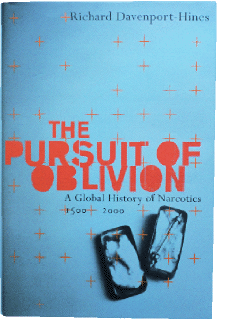High Anxiety
Tripping through the history of narcotics
Tripping through the history of narcotics

The oldest written language in existence, Sumerian, dates back at least as far as 3100BC. It contains an ideogram denoting the opium poppy as 'the plant of joy'. Since then, as Richard Davenport-Hines writes in the opening pages of his magisterial new book The Pursuit of Oblivion: a Global History of Narcotics 1500-2000 (2001): 'Intoxication is not unnatural or deviant. Absolute sobriety is not a natural or primary human state.' That said, this is a resolutely straight scholarly work, which aims to outline above all 'the history of one bad idea: prohibition'. Along the way, it also amasses a huge, unlikely cast of literary drug users.
Samuel Johnson 'once appeased a very troublesome cough' with opium 'in larger quantities than I like to take'. Sir Walter Scott found that 60 or 80 drops disagreed 'excessively' with him, and produced a bad hangover. Wilkie Collins became a hopeless slave to the drug, and wouldn't go anywhere without his flask of laudanum. Marcel Proust, apart from the amyl nitrate he sniffed nightly to soothe his asthma, 'half-destroyed' his memory 'by incessant medications' of barbiturates and opiate extracts. W. H. Auden was addicted to amphetamines throughout the 1940s and most of the 1950s, and found that his poetic production faltered without them.
Far more startling, though, are the various qualities that have been ascribed to different drugs throughout the centuries. Pliny the Elder describes how the Romans used opium to treat elephantiasis, carbuncles, liver complaints, epilepsy and scorpion bites. In 1664 Samuel Pepys attended 'an experiment of killing a dog by letting opium into his hind leg'. Restless little children were dosed with it during long journeys. William Gladstone took it in his coffee before addressing the House of Commons. In the cities of Japanese-controlled China in the 1930s there were officially sanctioned while-you-wait injection kiosks on the street to keep the colonized population quiet.
Cocaine has an equally chequered past. A youthful, impetuous Sigmund Freud advocated the drug as a cure for morphine addiction, and in his essay 'On Coca' (1884) touted its uses as a remedy for indigestion, malnutrition, typhoid and diabetes. He forgot to mention that he used it regularly himself to get through boring dinner parties. In the 1880s the Therapeutic Gazette reported that 'one feels like trying coca, with or without the opium habit. A harmless remedy for the blues is imperial.' Meanwhile products such as Ryno's Hay Fever and Catarrh Remedy were sold in the US during the 1890s for 'whenever the nose is stuffed up, red and sore'. The cocaine content of Ryno's was 99.9%. There was also, of course, always Coca-Cola.
The notion of a drug being used by writers and artists for aesthetic, rather than anaesthetic, reasons perhaps originated with Thomas de Quincey's notorious Confessions of an English Opium Eater, first serialized anonymously in a magazine in 1821 and published in book form the following year. Samuel Taylor Coleridge may have been the greater addict (as De Quincey pointedly suggested in a prominent footnote on the very first page of his account), and 'Kubla Kahn' (1797-8) may have been inspired by an opium dream. But Coleridge only wrote of taking laudanum to quell pain, whereas De Quincey described how he took the drug to go to the opera, and wandered into endless, ornate staircases and labyrinthine corridors of winding prose on its beatific qualities:
'That my pains had vanished was now a trifle in my eyes ... Here was a panacea ... for all human woes: here was the secret of happiness, about which philosophers had disputed for so many ages, at once discovered: happiness might now be bought for a penny and carried in the waistcoat pocket: portable ecstasies might be had corked up in a pint bottle: and peace of mind could be sent down in gallons by the mail coach.'
Charles Baudelaire's essays on opium and hash in Les Paradis Artificiels (1860) were first published alongside his own translations of De Quincey's work. The Club des Haschischins in Paris during the 1840s probably borrowed its Oriental trappings from the extended, nightmarish 'Asiatic scenes' of the Confessions. Fitz Hugh Ludlow's The Hasheesh Eater (1857) was surely written more under the influence of De Quincey than any narcotic. Unwittingly, the Opium Eater himself helped spawn a ridiculous and sublime line of Western drug literature usually to be found tucked discreetly away in bookshops on a shelf marked 'Cult Writing', leading down through Aleister Crowley, Antonin Artaud, Aldous Huxley, Henri Michaux and on to the Beats.
'Sobriety is not an easy state for human beings', writes Davenport-Hines, 'people are resourceful'. He cites the example of the choreographer Sir Frederick Ashton, who, 'when sedatives were scarce in London in 1943 ... doped himself with Calm Doggie, a canine tranquiliser to prevent barking during air-raids'. There's reams of fairly quirky, drily humorous evidence of this sort on display here, but the impassioned anti-prohibition arguments of The Pursuit of Oblivion are still utterly convincing. The international drug business today generates $400 billion annually: that's eight percent of all global trade. From this panoramic account of the problem through the ages, one thing you can say for sure is that it's not going to go away in a hurry.
















